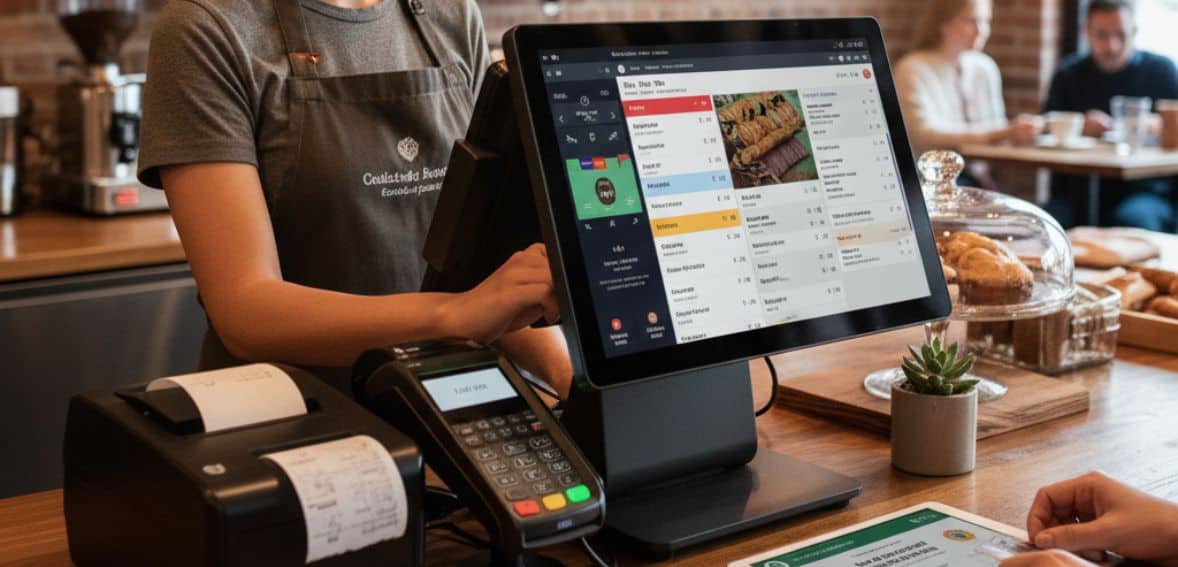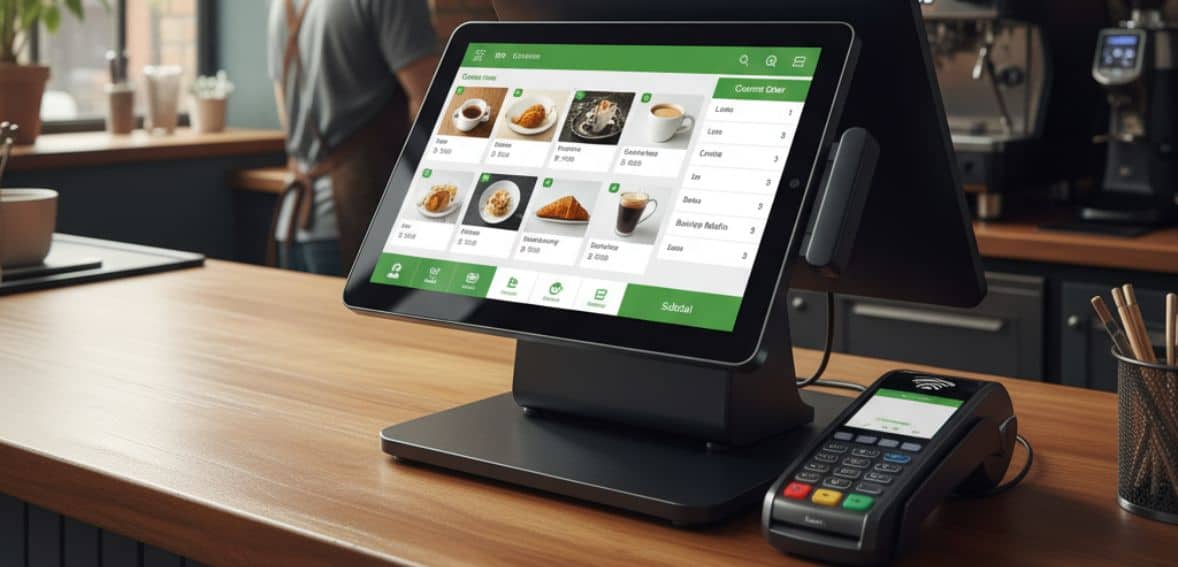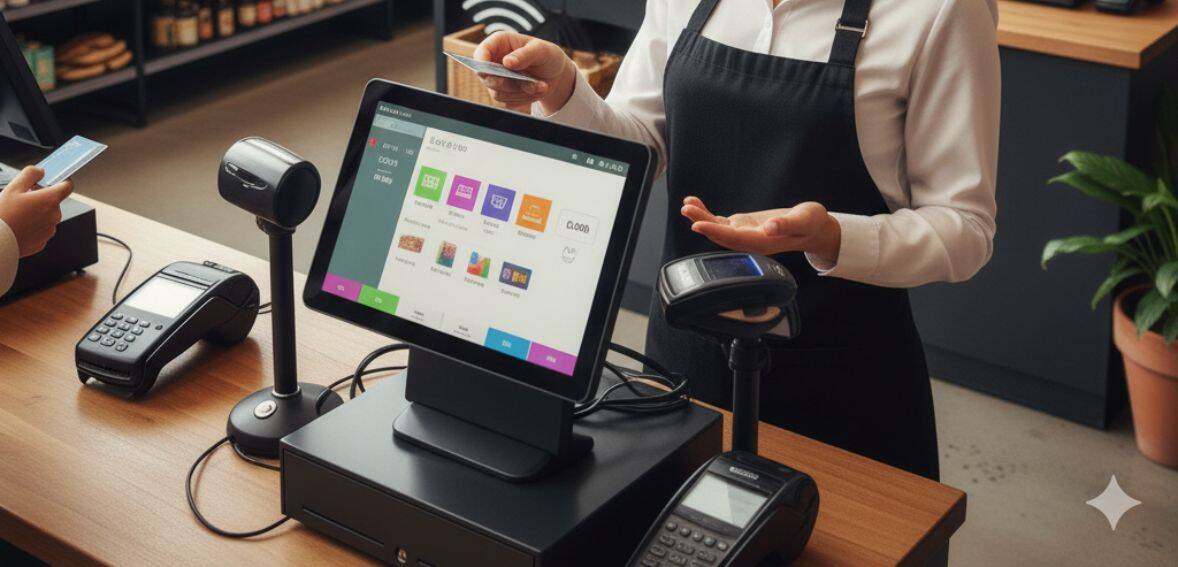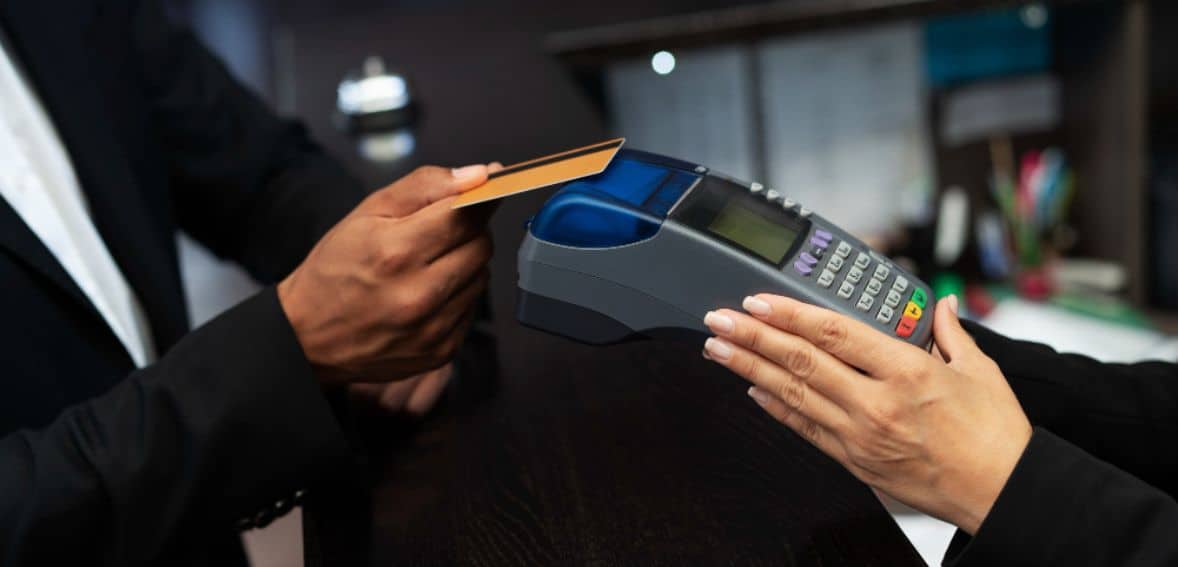
By Liam Stone September 24, 2025
All-in-one POS systems provide small businesses with an end-to-end solution for running sales, inventory, and customer information from a single platform. The systems make operations much more easier, more better and efficient, and minimize the necessity of different software applications.
With built-in functionalities such as payment processing, reporting, and inventory control, they enable small businesses to save increasingly more time, minimize mistakes, and provide better customer service.
The Evaluation of POS Systems
POS systems have evolved very significantly over time. In the 1970s, electronic cash registers processed simple transactions and sales tracking. The 1980s introduced computerized POS systems, then came more feature-rich systems in the 1990s, followed by cloud-based systems in the 2000s, and integrated all-in-one POS systems in the 2010s, finally concluding to the present modern seamless omnichannel and AI technology in the 2020s.
Although previous POS systems were able to perform some of the retail functions, they were not very capable of fulfilling all the demands of the current fast-moving market. Current retailers require systems that are integrated, convenient to use, and flexible. An all-in-one POS streamlines routine operations, cuts costs and time, and delivers seamless customer shopping both in-store and online.
Top Features of All-in-One POS Systems

Point of Sale Technology has numerous features that simplify and streamline the work of running a business. One such major feature is compatibility and integration. Contemporary POS software operates seamlessly with hardware such as wifi, barcode readers, cash drawers, and thermal printers. They also integrate with accounting programs, customer management software, and online shopping platforms, so information is transferred effortlessly, and you have fewer entries to do manually.
This integration allows companies to view the whole picture and make better decisions. Another critical aspect is scalability and the ability to keep up with growth. A suitable POS system will grow with your company, supporting more products, users, and stores without becoming sluggish.
It adjusts for increased transaction loads and tends to get updates to remain compatible with the latest technology and industry trends. This implies that you will not have to switch your system as your business grows, and it is a worthwhile long-term investment.
Staff training and support are also crucial. POS software should be designed to use easily, so employees can learn quickly. Most systems come with guides, tutorials, and responsive customer support to help solve problems. This ensures your team can use the system confidently and deliver better service to customers.
Finally, data security and compliance are key aspects. New POS systems keep sensitive payment data encrypted and tokenized for protection. They assist businesses in adhering to security guidelines such as PCI DSS and limit data access to authorized personnel only.
With robust security and compliance, you can keep your customers’ data safe, uphold trust, and comply with industry requirements without a care. These attributes collectively render all-in-one POS software an expert utility to control and expand your business effectively.
Benefits All-in-one POS

All-in-one POS systems introduce a variety of advantages that turn retail operations more efficient and easier. They enhance efficiency and convenience through streamlined checkout operations, system updates, and minimizing downtime, thereby contributing to more satisfied customers.
Lean design maximizes space, minimizes employees’ strain, and organizes the checkout space better, while robust hardware provides reliability and fewer interruptions.
These systems also improve the user experience by providing a uniform look and feel for in-store and online shopping, making transactions easy and professional. Although there is an initial investment, the long-term cost savings on software, maintenance, and support, plus enhanced customer satisfaction, make it a good investment.
Another benefit is scalability, where businesses can add features as they expand without having to replace the system all together. All-in-one POS systems boast robust reporting and analytics, allowing companies to monitor sales, stock, and customer activity and use this information to develop targeted marketing campaigns and monitor key performance indicators.
Integrated capabilities link all areas of the business within one system, minimizing the use of multiple systems. Last but not least, real-time visibility allows owners and managers to see what is happening and make immediate decisions remotely, keeping the business responsive and efficient at all times.
Disadvantages of the One Pos System

A drawback of an all-in-one POS system is that it has limited configuration possibilities. Although it is an easy solution, it may not always exactly match your business requirements. You will have to adapt your procedures to the system capabilities. Moreover, the systems are usually accompanied by functionalities you may not require, which might make your operations unnecessarily more complex and confusing.
Another disadvantage is the dependency on one vendor for all maintenance, updates, and support. If the vendor has problems or closes its shop, it might compromise your operations, exposing you to risk.
Traditional vs Modern All-in-One POS Systems

Aspect | All-in-One POS | Traditional POS |
Cost | Generally more cost-effective due to bundled hardware and software, ideal for small to medium-sized businesses. | Can be more expensive due to separate purchases and potentially higher maintenance costs. |
Installation and Setup | Quick and straightforward, requiring minimal technical expertise. | May require professional installation and more time due to multiple components. |
Maintenance and Support | Easier to maintain with unified support for both hardware and software from a single provider. | Maintenance is more complex, requiring support from multiple vendors for different components. |
Flexibility | Best suited for businesses looking for a streamlined, easy-to-use solution with basic to intermediate features. | Ideal for businesses requiring extensive customization and advanced features, especially larger enterprises. |
Scalability | May have limitations on scaling for large operations or highly specialized needs. | Highly scalable, suitable for large enterprises with complex needs or multiple locations. |
Software Integration | Pre-built software that integrates seamlessly with hardware, making it more user-friendly. | Requires separate integration of software and hardware, which can be time-consuming and complicated. |
Top All In One POS Providers In 2025
Square
Square’s All-in-One POS system makes business easy. It allows you to accept various forms of payment, such as credit cards processing and mobile wallets. You can monitor inventory, customer data, and real-time sales data in one location. Square also includes features to manage employees’ workflow, such as hours tracking and payroll processing.
Since it’s cloud-based, you have access to your data from anytime, anywhere. Also Square’s system is simple to install and navigate, with the ability to customize hardware and integrate other apps. It also includes 24/7 customer support to assist whenever you need it.
Plan | Description | Price | Processing Fees |
Free | Sell in person, online, over the phone, or in the field. No setup or monthly fees — pay only when you accept payments. | $0/month | + processing fees |
Plus | Advanced features for restaurants, retailers, or appointment-based businesses. Upgrade anytime and cancel whenever. | $29+/month | + processing fees |
Premium | Custom plan tailored to complex operations. Custom processing rates may be available based on eligibility. | Custom pricing | + processing fees |
Lightspeed
Lightspeed provides a full suite of tools created to make business operations simpler, with an easier way to manage everything from inventory to customer relationships. Lightspeed provides one register as part of the package, as well as in-depth features such as inventory management, which can integrate perfectly with e-commerce and mobile apps.
You can monitor stock in real-time, generate in-depth reports, and assign custom user permissions to control access. The system also has premium loyalty programs as well as flexible payment methods, including access to Lightspeed Capital with easy repayment terms. There is also support 24/7 through chat and phone, making help a call away.
Plan | Description | Price | Contact |
Basic | Designed for essential day-to-day needs for independent retailers. | $89 USD/mo | Contact sales |
Core | Ideal for retailers seeking management tools to facilitate business growth. | $149 USD/mo | Contact sales |
Plus | Tailored for advanced customization and ease of scalability in established retail operations. | $289 USD/mo | Contact sales |
Touch Bistro
POS software plans include a variety of useful features to improve business operations. You can operate your menu, modify items, and monitor sales in real-time. The table management capabilities enable you to schedule seating and optimize customer service.
Detailed reporting and analytics give you insights into performance, inventory, and sales. Staff management functionality allows you to manage scheduling shifts, hours, and performance. Tableside ordering simplifies ordering, enhancing speed and accuracy. Also, smooth integrations with all other software simplify connecting everything from accounting to customer management very easily.
Plan | Description | Price |
TouchBistro POS | Cloud-based POS system with essential features for restaurant management. | Starting at $69/mo |
Shopify
Shopify all in one POS plans give you some fantastic extras to grow your business. You have the world’s top checkout experience, Shopify checkout helps to convert 15% higher on average than other platforms. You’re able to sell in person and have your inventory stay connected to online sales.
Additionally, you can reach more customers by selling on several platforms such as Instagram, TikTok, and Google. In-depth analytics enable you to see how your store is performing and where to make improvements. With a variety of commerce apps available, you can tailor your store and simplify everything from product sourcing to customer engagement
Plan | Description | Price (USD) | Card Rates | Standout Features |
Basic | Most popular for solo entrepreneurs | $24.00/month | 2% 3rd-party payment providers | 10 inventory locations, 24/7 chat support, In-person selling by phone or POS device |
Grow | For small teams | $89.00/month | 1% 3rd-party payment providers | 10 inventory locations, 24/7 chat support, 5 staff accounts, In-person selling by phone or POS device |
Advanced | As your business scales | $365.00/month | 0.6% 3rd-party payment providers | 10 inventory locations, Enhanced 24/7 chat support, Local storefronts by market, 15 staff accounts |
Plus | For more complex businesses | $2,100 (3-year) | Competitive rates for high-volume merchants | 200 inventory locations, Priority 24/7 phone support, Local storefronts by market, Unlimited staff accounts, Fully customizable checkout, Up to 200 POS Pro locations, Sell wholesale/B2B |
How to Select the Ideal All-in-One POS System

Step 1: Determine Your Needs
Search for pain points in your existing system, such as order mistakes or cumbersome tasks. Knowing what is not operating well in your day-to-day business serves to identify what features are critical for a new POS system. This evaluation ensures that you select a system addressing your business’s particular issues and operational objectives directly.
Step 2: Know What to Look For
Search for a POS system that makes reporting, inventory control, and processing payments easier. Choose one that is easy to use and has good customer support. The system must also be scalable, i.e., it must grow with your restaurant as your business grows.
Step 3: Research Your Options
Do thorough research by reading reviews and asking fellow restaurant owners about their experiences. Getting real-world feedback from those who use the system daily can help to guide your decision. Narrow your choices to systems praised for reliability, ease of use, and strong support, then start building your shortlist for further evaluation.
Step 4: Schedule a Demo
Arrange demos with prospective POS providers to observe how their systems operate in practice. Bring a list of questions that highlights particular concerns, such as transaction velocity or menu changes. Notice how easy the system is to use and if it will integrate easily with your current restaurant workflow for smooth operations.
Step 5: Gauge the Total Cost
Take both initial and recurring expenses into consideration when comparing a POS system. Check for hardware, software, and maintenance charges. Additionally, some systems might impose additional fees for premium features or upgrades. Knowing the total cost of ownership allows you to choose a system that is within your budget and offers long-term value for your business.
Step 6: Make the Final Selection
Once you’ve narrowed down your options, compare each system’s features with your needs. Think about how easily it integrates with your existing processes and whether it offers the best value. Choose the system that not only meets your current requirements but also has the potential to grow with your business.
Step 7: Final Decision and Negotiation
After selecting your POS system, negotiate with the vendor for the best deal. Discuss payment terms, potential discounts, and additional features or support options. Be clear about what you’re getting and ensure the contract reflects your needs to avoid any surprises after you’ve committed to the system.
Conclusion
All-in-one POS systems are a game-changer for small businesses, providing convenience, efficiency, and cost savings. By combining critical functions in one platform, these systems streamline day-to-day operations, enhance customer service, and facilitate business growth. With their flexibility and user-friendliness, investing in an all-in-one POS system can lead to success and smoother, more efficient business management in the long term.
FAQs
What is an all-in-one POS system?
An all-in-one POS system combines payment processing, inventory management, and customer information into one system. It makes business easier and more efficient.
How does an all-in-one POS system help small businesses?
It makes daily operations easier, lowers operating expenses, and strengthens customer experience by bringing several functionalities together into a single, simple-to-use platform.
Is an all-in-one POS system simple to implement?
Yes, most systems are made for simple installation and integration with current business processes, minimizing setup time and hassle.
Can an all-in-one POS system expand with my business?
Absolutely. These systems are designed to grow with your business, providing features and upgrades that evolve with changing requirements.
How secure is an all-in-one POS system?
Current all-in-one POS systems employ encryption and adherence to industry standards, securing transactions and protecting data.